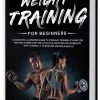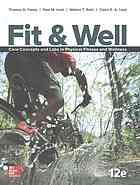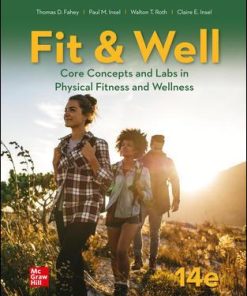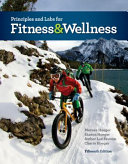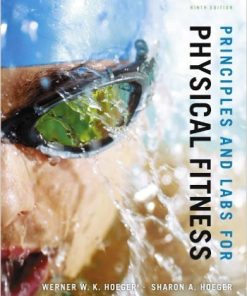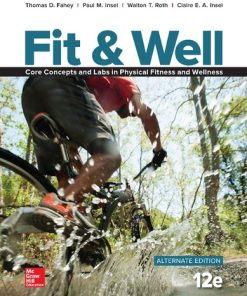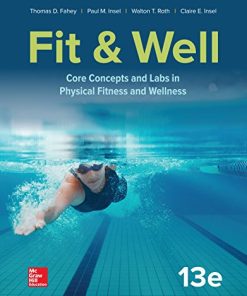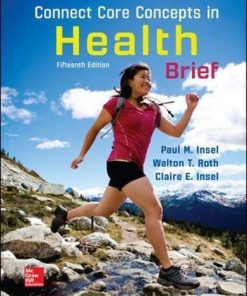(Ebook PDF) Fit & Well Core Concepts and Labs in Physical Fitness and Wellness 15th Edition by Thomas Fahey, Paul Inse, Walton Roth 126439330X 9781264393305 full chapters
$50.00 Original price was: $50.00.$25.00Current price is: $25.00.
Fit & Well: Core Concepts and Labs in Physical Fitness and Wellness 15th Edition by Thomas Fahey, Paul Inse, Walton Roth – Ebook PDF Instant Download/DeliveryISBN: 126439330X, 9781264393305
Full dowload Fit & Well: Core Concepts and Labs in Physical Fitness and Wellness 15th Edition after payment.
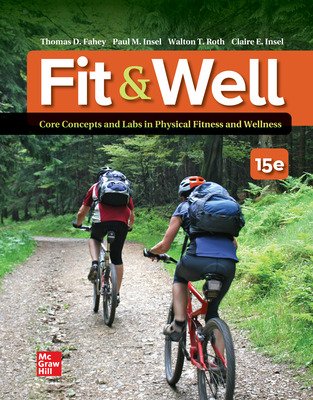
Product details:
ISBN-10 : 126439330X
ISBN-13 : 9781264393305
Author: Thomas Fahey, Paul Inse, Walton Roth
Fit and Well gives students the knowledge and skills to make meaningful and lasting behavior changes. The most trusted and proven science-based content in a new edition and digital teaching and learning tools help college students improve their exercise eating and stress management habits. Fit and Well is written by experts who work and teach in the fields of exercise science physical education and health education. Fit and Well provides accurate reliable current information on key health and fitness topics while also addressing issues related to mind-body health diversity research and consumer health.UPDATES INFORMED BY STUDENT DATA Changes to this edition reflect new research findings updated statistics and current hot topics like COVID-19 that impact students’ fitness and wellness behaviors. Revisions were also guided by student performance data collected anonymously from the tens of thousands of students who have used SmartBook with Fit and Well.
Fit & Well: Core Concepts and Labs in Physical Fitness and Wellness 15th Table of contents:
1 Introduction to Wellness, Fitness, and Lifestyle Management
Wellness: New Health Goals
The Dimensions of Wellness
New Opportunities for Taking Charge
National Health
Behaviors That Contribute to Wellness
Wellness Factors That Seem Outside Our Control
College Students and Wellness
Reaching Wellness Through Lifestyle Management
Getting Serious about Your Health
Building Motivation to Change
Enhancing Your Readiness to Change
Dealing with Relapse
Developing Skills for Change: Creating a Personalized Plan
Putting Your Plan into Action
Staying with It
Being Fit and Well for Life
Tips for Today and the Future
Summary
For Further Exploration
Selected Bibliography
LAB 1.1 Your Wellness Profile
LAB 1.2 Lifestyle Evaluation
2 Principles of Physical Fitness
Physical Activity and Exercise for Health and Fitness
Physical Activity on a Continuum
How Much Physical Activity Is Enough?
Components of Physical Fitness
Cardiorespiratory Endurance
Muscular Strength
Muscular Endurance
Flexibility
Body Composition
Skill (Neuromuscular)–Related Components of Fitness
Principles of Physical Training: Adaptation to Stress
Specificity—Adapting to Type of Training
Progressive Overload—Adapting to the Amount of Training and the FITT Principle
Reversibility—Adapting to a Reduction in Training
Individual Differences—Limits on Adaptability
Designing Your Own Exercise Program
Getting Medical Clearance
Assessing Yourself
Setting Goals
Choosing Activities for a Balanced Program
Guidelines for Training
Tips for Today and the Future
Summary
Common Questions Answered
For Further Exploration
Selected Bibliography
LAB 2.1 Safety of Exercise Participation: PAR-Q+
LAB 2.2 Overcoming Barriers to Being Active
LAB 2.3 Using a Fitness Tracker or Smartphone Exercise App to Measure Physical Activity
3 Cardiorespiratory Endurance
Basic Physiology of Cardiorespiratory Endurance Exercise
The Cardiorespiratory System
Energy Production
Exercise and the Three Energy Systems
Benefits of Cardiorespiratory Endurance Exercise
Improved Cardiorespiratory Functioning
Improved Cellular Metabolism
Reduced Risk of Chronic Disease
Better Control of Body Fat
Improved Immune Function
Improved Psychological and Emotional Well-Being
Assessing Cardiorespiratory Fitness
Choosing an Assessment Test
Monitoring Your Heart Rate
Interpreting Your Score
Developing a Cardiorespiratory Endurance Program
Setting Goals
Applying the FITT Principle
Warming Up and Cooling Down
Building Cardiorespiratory Fitness
Maintaining Cardiorespiratory Fitness
Exercise Safety and Injury Prevention
Hot Weather and Heat Stress
Cold Weather
Poor Air Quality
Exercise Injuries
Tips for Today and the Future
Summary
Common Questions Answered
For Further Exploration
Selected Bibliography
LAB 3.1 Assessing Your Current Level of Cardiorespiratory Endurance
LAB 3.2 Developing an Exercise Program for Cardiorespiratory Endurance
4 Muscular Strength and Endurance
Basic Muscle Physiology and the Effects of Strength Training
Muscle Fibers
Motor Units
Metabolic and Heart Health
Assessing Muscular Strength and Endurance
Creating a Successful Strength Training Program
Static versus Dynamic Strength Training Exercises
Weight Machines, Free Weights, and Body Weight Exercises
Other Training Methods and Types of Equipment
Applying the FITT Principle: Selecting Exercises and Putting Together a Program
The Warm-Up and Cool-Down
Getting Started and Making Progress
More Advanced Strength Training Programs
Weight Training Safety
Supplements and Drugs
Tips for Today and the Future
Weight Training Exercises
Common Questions Answered
Summary
For Further Exploration
Selected Bibliography
LAB 4.1 Assessing Your Current Level of Muscular Strength
LAB 4.2 Assessing Your Current Level of Muscular Endurance
LAB 4.3 Designing and Monitoring a Strength Training Program
5 Flexibility and Low-Back Health
Types of Flexibility
What Determines Flexibility?
Joint Structure
Muscle Elasticity and Length
Nervous System Regulation
Benefits of Flexibility
Joint Health
Prevention of Low-Back Pain and Injuries
Additional Potential Benefits of Flexibility
Assessing Flexibility
Creating a Successful Program to Develop Flexibility
Applying the FITT Principle
Making Progress
Exercises to Improve Flexibility: A Sample Program
PREVENTING AND MANAGING LOW-BACK PAIN
Function and Structure of the Spine
Core Muscle Fitness
Causes of Back Pain
Preventing Low-Back Pain
Managing Acute Back Pain
Managing Chronic Back Pain
Exercises for the Prevention and Management of Low-Back Pain
Tips for Today and the Future
Summary
Common Questions Answered
For Further Exploration
Selected Bibliography
LAB 5.1 Assessing Your Current Level of Flexibility
LAB 5.2 Creating a Personalized Program for Developing Flexibility
LAB 5.3 Assessing Muscular Endurance for Low-Back Health
6 Body Composition
What is Body Composition, and Why is it Important?
Overweight and Obesity Defined
Prevalence of Overweight and Obesity among Americans
Excess Body Fat and Wellness
Problems Associated with Very Low Levels of Body Fat
Assessing Body Mass Index, Body Composition, and Body Fat Distribution
Calculating Body Mass Index
Estimating Percent Body Fat
Assessing Body Fat Distribution
Somatotype
Setting Body Composition Goals
Making Changes in Body Composition
Tips for Today and the Future
Summary
For Further Exploration
Selected Bibliography
Common Questions Answered
LAB 6.1 Assessing Body Mass Index and Body Composition
LAB 6.2 Setting Goals for Target Body Weight
7 Putting Together a Complete Fitness Program
Developing a Personal Fitness Plan
1. Set Goals
2. Select Activities
3. Set a Target Frequency, Intensity, and Time (Duration) for Each Activity
4. Set Up a System of Mini-Goals and Rewards
5. Include Lifestyle Physical Activity and Strategies to Reduce Sedentary Time in Your Program
6. Develop Tools for Monitoring Your Progress
7. Make a Commitment
Putting Your Plan Into Action
Exercise Guidelines for Life Stages and People with Special Health Concerns
Exercise Guidelines for Life Stages
Exercise Guidelines for People with Special Health Concerns
Common Questions Answered
Summary
For Further Exploration
Selected Bibliography
Sample Programs for Popular Activities
LAB 7.1 A Personal Fitness Program Plan and Agreement
LAB 7.2 Getting to Know Your Fitness Facility
8 Nutrition
Nutritional Requirements: Components of a Healthy Diet
Calories
Proteins—The Basis of Body Structure
Fat—Another Essential Nutrient
Carbohydrates—A Key Source of Energy
Fiber—A Closer Look
Vitamins—Organic Micronutrients
Minerals—Inorganic Micronutrients
Water—Vital but Underappreciated
Other Substances in Food
Nutritional Guidelines: Planning Your Diet
Dietary Reference Intakes (DRIs)
Daily Values
Dietary Guidelines for Americans
USDA’s MyPlate
Other Eating Plans
The Plant-Based Alternative
Functional Foods
Dietary Challenges for Various Population Groups
Nutritional Planning: Making Informed Choices About Food
Food Labels
Calorie Labeling: Restaurants and Vending Machines
Dietary Supplements
Food Additives
Foodborne Illnesses
Irradiated Foods
Environmental Contaminants and Organic Foods
A Personal Plan
Assessing and Changing Your Diet
Staying Committed to a Healthy Diet
Tips for Today and the Future
Summary
Common Questions Answered
For Further Exploration
Selected Bibliography
LAB 8.1 Your Daily Diet versus MyPlate
LAB 8.2 Dietary Analysis
LAB 8.3 Informed Food Choices
9 Weight Management
What Contributes to Our Weight and Body Composition?
Genetic Factors
Fat Cells
Metabolism
Hormones
Gut Microbiota
Sleep
Food Marketing and Public Policy
Food Perceptions and Behaviors
THE OVERWEIGHT AND OBESITY CRISIS
Obesity and Health
Assessing Weight and Disease Risk
Body Image
Severe Body Image Problems
Healthy Change and Acceptance
Eating Disorders
Disordered Eating
Anorexia Nervosa
Bulimia Nervosa
Binge-Eating Disorder
Other Specified Feeding or Eating Disorders (OSFED)
Treating Eating Disorders
A Healthy Lifestyle for Managing Weight and Disease Prevention
Dietary Patterns and Eating Habits
Physical Activity and Exercise
Thoughts and Emotions
Coping Strategies
Approaches to Overcoming a Weight Problem
Losing Weight
Gaining Weight
Tips for Today and the Future
Summary
For Further Exploration
Common Questions Answered
Selected Bibliography
Lab 9.1 Evaluate Your Environment for Weight Management
LAB 9.2 Identifying Weight-Loss Goals
LAB 9.3 Checking for Body Image Problems and Eating Disorders
10 Stress Management and Sleep
What Is Stress?
Physical Responses to Stressors
Cognitive and Psychological Responses to Stressors
The Stress Experience as a Whole
Stress and Wellness
The General Adaptation Syndrome
More Recent Ideas about Stress
Stress and Specific Conditions
Common Sources of Stress
Major Life Changes
Daily Hassles
College Stressors
Job-Related Stressors
Relationships and Stress
Social Stressors
Other Stressors
Managing Stress
Exercise
Nutrition
Social Support
Communication
Conflict Resolution
Striving for Spiritual Wellness
Confiding in Yourself through Writing
Time Management
Cognitive Techniques
Relaxation and Body Awareness Techniques
Other Stress-Management Techniques
Counterproductive Strategies for Coping with Stress
Getting Help
Peer Counseling and Support Groups
Professional Help
Is It Stress or Something More Serious?
Sleep
How Sleep Works: The Physiology of Sleep
Natural Sleep Drives
Adequate Sleep and Your Health
Sleep Disorders
Improving Sleep
Tips for Today and the Future
Common Questions Answered
Summary
For Further Exploration
Selected Bibliography
LAB 10.1 Identifying Your Stress Level and Key Stressors
LAB 10.2 Stress-Management Techniques
LAB 10.3 Evaluating and Improving Sleep
11 Cardiovascular Health and Diabetes
Major Forms of Cardiovascular Disease
Atherosclerosis
Heart Disease and Heart Attacks
Stroke
Congestive Heart Failure
Risk Factors for Cardiovascular Disease
Major Risk Factors That Can Be Changed
Contributing Risk Factors That Can Be Changed
Major Risk Factors That Can’t Be Changed
Possible Risk Factors Currently Being Studied
Protecting Yourself Against Cardiovascular Disease
Eat a Heart-Healthy Diet
Exercise Regularly
Avoid Tobacco
Know and Manage Your Blood Pressure
Know and Manage Your Cholesterol Levels
Develop Ways to Handle Stress and Anger
Diabetes
Types of Diabetes
Warning Signs and Testing
Treatment
Prevention
Common Questions Answered
Tips for Today and the Future
Summary
For Further Exploration
Selected Bibliography
LAB 11.1 Cardiovascular Health
12 Cancer
What is Cancer?
Tumors
Metastasis
The Causes of Cancer
Tobacco Use
Alcohol Use
Dietary Factors
Obesity and Inactivity
The Role of DNA
Race/Ethnicity and Poverty
Carcinogens in the Environment
Common Cancers
Lung Cancer
Colon and Rectal Cancer
Breast Cancer
Prostate Cancer
Cancers of the Female Reproductive Tract
Skin Cancer
Head and Neck Cancers
Testicular Cancer
Other Cancers
Detecting and Treating Cancer
Detecting Cancer
Stages of Cancer
Treating Cancer
Tips for Today and the Future
Common Questions Answered
Summary
For Further Exploration
Selected Bibliography
LAB 12.1 Cancer Prevention
13 Substance Use and Misuse
Addiction
Diagnosing Substance Misuse and Addiction
How Does an Addiction Develop?
Examples of Behavioral Addictions
Psychoactive Drugs
Who Uses Drugs?
Opioids and Drug Overdose Deaths
Marijuana
Other Illicit Drugs of Concern
Treatment for Substance Use Disorder and Addiction
Preventing Substance Use Disorder
The Role of Drugs in Your Life
Alcohol
Chemistry and Metabolism
Immediate Effects of Alcohol
Alcohol Use Disorder: From Mild to Severe
Effects of Alcohol Use Disorder
Drinking and Driving
Binge Drinking
Drinking and Responsibility
Tobacco
Nicotine Addiction
Health Hazards of Cigarette Smoking
Risks Associated with Other Forms of Tobacco Use
Environmental Tobacco Smoke
Smoking and Pregnancy
Giving Up Tobacco
Action against Tobacco
Common Questions Answered
Tips for Today and the Future
Summary
For Further Exploration
Selected Bibliography
LAB 13.1 Is Alcohol a Problem in Your Life?
LAB 13.2 For Smokers Only: Why Do You Smoke?
14 Sexual Wellness
Sex and Your Body
Sexual Anatomy
Gender and Sexual Orientation
Sexual Stimulation and Behavior
Contraception
How Contraceptives Work
Contraceptive Effectiveness
The Major Stis
HIV Disease and AIDS
Chlamydia
Gonorrhea
Pelvic Inflammatory Disease
Human Papillomavirus (HPV)
Genital Herpes
Hepatitis B
Syphilis
Other STIs
What You Can do About Stis
Tips for Today and the Future
Summary
Common Questions Answered
For Further Exploration
Selected Bibliography
LAB 14.1 Behaviors and Attitudes Related to STIs
15 Environmental Health
Environmental Health Defined
Population Growth and Control
Factors That Contribute to Population Growth
How Many People Can the World Hold?
Air Quality and Pollution
Air Quality and Smog
The Greenhouse Effect and Global Warming
Thinning of the Ozone Layer
Energy Use and Air Pollution
Indoor Air Pollution
Preventing Air Pollution
Water Quality and Pollution
Water Contamination and Treatment
Water Shortages
Sewage
Protecting the Water Supply
Solid Waste Pollution
Solid Waste
Reducing Solid Waste
Chemical Pollution and Hazardous Waste
Asbestos
Lead
Pesticides
Mercury
Other Chemical Pollutants
Preventing Chemical Pollution
Radiation Pollution
Nuclear Weapons and Nuclear Energy
Medical Uses of Radiation
Radiation in the Home and Workplace
Avoiding Radiation
Noise Pollution
Common Questions Answered
Tips for Today and the Future
Summary
For Further Exploration
Selected Bibliography
People also search for Fit & Well: Core Concepts and Labs in Physical Fitness and Wellness 15th:
fit & well core concepts
g-core labs
g-core labs s.a
j&j core values
qc core wellness
You may also like…
Medicine
Principles and Labs for Fitness and Wellness 1st edition by Werner Hoeger 133709997X 9798214351278
Uncategorized
Relationships & Lifestyle - Diet & Nutrition
Uncategorized
(eBook PDF) Fit & Well: Core Concepts and Labs in Physical Fitness and Wellness 14th Edition
Relationships & Lifestyle - Diet & Nutrition
Fit & Well: Core Concepts and Labs in Physical Fitness and Wellness 12th Edition
Uncategorized
Fit & Well: Core Concepts and Labs in Physical Fitness and Wellness 13th Edition – Ebook PDF Version


